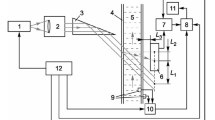Abstract
The heat conduction equation is solved in this paper under specific boundary conditions. The coefficients of the obtained distribution equation are simplified with the piecewise integral method. Then the associated model for the cylindrical thermal equipment is established. The relationship of the surface temperatures, the material properties and the inner wall state of the cylindrical thermal equipment is described in the associated model. This model is applied to the inner wall running state monitoring of the main pipe. A multi-channel distributed optical fiber temperature measurement system is designed to acquire the external surface temperatures of the main pipe. Then the associated model can be used to analyze the surface temperature data of the main pipe. The location and the physical dimension of the inner wall defect can be got. Therefore, the inner wall defect monitoring of the main pipe can be realized. The feasibility of this method is verified by experiment. This method also provides a theoretical basis for the real-time monitoring of the main pipe’s internal state.
Similar content being viewed by others
Abbreviations
- R 0 :
-
outer wall radius of the cylinder
- L :
-
axial length of the cylinder
- T ∞ :
-
ambient temperature
- T 0 :
-
inner wall temperature of the cylinder
- r :
-
any point radius within the cylinder
- l :
-
any point axial length within the cylinder
- T :
-
any point temperature within the cylinder
- ξ=l/R 0 :
-
dimensionless axial length
- Θ=(T-T)/(T 0-T ∞):
-
dimensionless temperature
- φ :
-
defect azimuth angle
- ρ=r/R 0 :
-
dimensionless radius
- k :
-
coefficient of heat conduction
- h ∞ :
-
convective heat transfer coefficient of the outside surface
- B i∞ = R 0 h ∞/k :
-
Biot number
References
Kassab A J, Hsieh C K. Solution of the inverse geometric problem for the detection of subsurface cavities by the IR-CAT method. Rev Sci Instrum, 1997, 58(1): 33–65
Sahnoun S, Belattar S. Thermal non destructive testing study of a circular defect in plane structure. British J NDT, 2003, 8 (08): 115–121
Huang C H, Chaing M T. A three-dimensional inverse geometry problem in identifying irregular boundary configurations. Int J Therm Sci, 2009, 48(3): 502–513
Sakagami T, Kubo S. Applications of pulse heating thermography and lock-in theromography to quantitative nondestructive evaluations. Infrared PhysTechnol, 2002, 43(3–5): 211–218
Chen C H, Su C R. Inverse estimation for temperatures of outer surface and geometry of inner surface of furnace with two layer walls. Energy Conver Manag, 2008, 49: 301–310
Gou X L, Zhang J T, Wang G J. Defects detection in the inner surface of pipes based on inverse heat conduction problem (in Chinese). J Chongqing Univ, 2010, 33(2): 42–46
Fan C L, Sun F R, Yang L. Algorithm for solution of inverse geometry problem (in Chinese). CIESC J, 2010, 61(11): 2783–2788
Feng L C, Tao N, Xu C. Lock-in thermography and its application in nondestructive evaluation (in Chinese). Infrared Laser Eng, 2010, 39(6): 1120–1123
Wang Q X, Song L M, Yang Z K. Solving process of three dimension cylindrical system with infrared CAT (in Chinese). Energy Metallurg Indus, 1995, 3(14): 45–49
Guan R H, Yu H. Feasibility to the infrared thermo-diagnosis of the defects in the inner wall of three dimensional cylinder-shaped equipment by means of numerical experiment (in Chinese). Laser and Infrared, 2002, 32(1): 37–39
Kang W X. Infrared therm-diagnosis to internal condition of the double-layer hollow cylinder-shaped heat equipment (in Chinese). Laser and Infrared, 2009, 39(10): 68–69
Ozisik M N. Heat Conduction. 2nd Revised ed. New York: John Wiley, 1993
Tian L P. Mathematical Physics Equation and Its Inverse Problem Research (in Chinese). Beijing: China Machine Press, 2010
Liu H L, Zhuang S L, Zhang Z X. The dynamic base matching method to increase the stability of distributed optical fiber temperature sensors (in Chinese). Proc SPIE, 2002, 4920: 295–298
Crickmore R I, Gunning M J, Dakin J P. Beat frequency measurement system for multiple dual polarization fiber DFB lasers. Sensors J, 2003, 3(1): 115–120
Zhou X J, Du D, Gong J J. Study on spatial resolution of polarized-modes coupling distributed fiber optic sensor (in Chinese). Acta Phys in, 2005, 54(5): 2106–2110
Author information
Authors and Affiliations
Corresponding author
Rights and permissions
About this article
Cite this article
Zhang, Y., Zhou, S. & Fu, X. Inner wall running state monitoring for the main pipe of nuclear power. Sci. China Technol. Sci. 56, 2606–2614 (2013). https://doi.org/10.1007/s11431-013-5332-0
Received:
Accepted:
Published:
Issue Date:
DOI: https://doi.org/10.1007/s11431-013-5332-0




